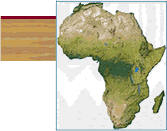U.S. TRADE AND INVESTMENT IN SUB-SAHARAN AFRICA
The United States seeks a stable, economically dynamic and democratic
Africa with which
it can trade, in which it can invest profitably, and with which it can
work to advance
U.S. interests globally. This goal will be impossible to achieve unless
and until Africa
is fully integrated into the global economy. To this end, President
Clinton's Partnership
for Economic Growth and Opportunity in Africa, announced last June, is
intended to spur
African nations to implement significant economic reforms to achieve
sustainable growth
and development. By supporting African reform efforts, the Partnership
also seeks to
create opportunities for U.S. companies to trade with and invest in
Africa, to create U.S.
jobs and further our mutual prosperity.
As economic reforms take hold, African nations are becoming players in
the global
trading system, creating new opportunities for American business. U.S.
trade with
Sub-Saharan Africa has grown on average by 16.9 percent annually since
1994, outpacing
growth in global trade in 1995 and 1996. U.S. exports to Africa reached
$6.2 billion in
1997, while African exports to the U.S. -- 70 percent of which are
crude oil --
totaled $16.4 billion. Africa's $10.2 billion trade surplus with the
United States in 1997
accrued almost entirely to oil exporters.
Although U.S. exports to the region account for less than
1 percent of total U.S.
exports, U.S. exports to Africa now exceed by 20% those to all of the
former Soviet Union
combined. Manufactured exports accounted for 86% and agricultural exports
14 percent
of U.S. shipments to the region in 1996. Yet the United States accounts
for only 7 percent
of Africa's imports, putting it in third place among industrial country
suppliers to the
continent. As the huge, mostly untapped African market of 660 million
people grows and our
market share increases, thousands of new American jobs will be created.
Return on U.S. direct investment in Africa has been dramatic. During
1990-94, the
average annual return on book value of U.S. direct investment in Africa
was nearly
28 percent, three times the rate of worldwide return. And in 1995
and 1996, the
return on book value exceeded 30 percent. High rates of return reflect
investor
perceptions of high risk in Africa, but high returns also mean that
Africa has significant
opportunities for investors who know where to look.
At year-end 1996, U.S. direct investment in Sub-Saharan Africa totaled
$4.9 billion, up
11 percent from 1995 and 30 percent from 1994. A total of $1.4
billion of that
position was in South Africa, exceeding the value of U.S. investments in
major emerging
markets such as Turkey and India. U.S. investment in South Africa is
mostly in
manufacturing. Elsewhere in the region U.S. investment is largely in
petroleum and mining.
U.S. direct investment in Africa supports U.S. trade with the region
and fuels American
industry. For example, U.S. merchandise exports, valued at $684 million,
were shipped to
U.S. majority-owned affiliates in Africa in 1994.
![]()


![[White House icon]](/New/images/home_pin.gif)
![[Help Desk icon]](/New/images/help_pin.gif)